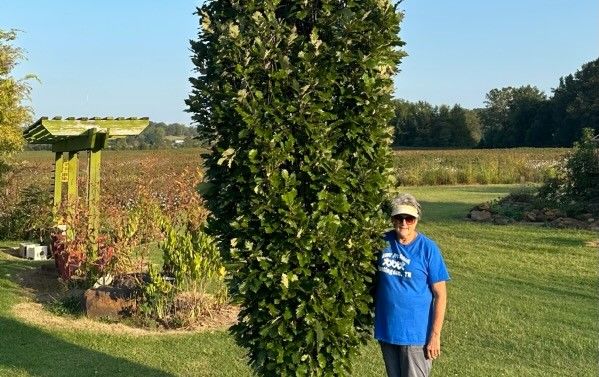
UT Gardens’ November Plant of the Month
Submitted by Jason Reeves Curator of the UT Gardens Jackson
In 1974 the legendary nurseryman Earl Cully planted a thousand acorns from a cross of the columnar English oak (Quercus robur ‘Fastigiata’) with our native swamp white oak (Q. bicolor). Only a few of the hundreds of seedlings had the desired attributes of both species that Cully was looking for and made it into his final cut. Regal Prince® was Cully’s first introduction and Quercus × warei ‘Nadler’ Kindred Spirit®, with an even tighter habit, was the second.
The original Kindred Spirit is located in Jacksonville, Illinois, on what was once Mr. Cully’s property. It is over 40 years old and has long since proven itself. From its American swamp white oak parentage, it inherited the ability to tolerate constantly damp, as well as dry soil, cold hardiness, heat tolerance, powdery mildew resistance and limbs that withstand wind and ice.
The shiny, dark, leathery leaves have silvery green undersides and are particularly noticeable when dancing in the wind. In fall, the foliage turns golden brown before dropping to reveal a strong framework of upswept branches. Despite being a hybrid, it produces attractive medium size acorns that provide a food source for small mammals.
Rising like an exclamation point, Kindred Spirit serves as a powerful vertical element in the landscape and its tight upright habit gives it a formal feel. The tree makes a bold focal point, and when planted in a row, forms a handsome property-defining screen or windbreak. Due to its hybrid nature, it possesses “hybrid vigor.” When grown in average to good garden conditions it will be fast-growing in its youth. A young Kindred Spirit can easily grow 12- to 24-inches a year. Expect it to reach 30- to 40-feet tall and 6- to 7-feet wide in 30 years. Kindred Spirit prefers a sunny site and average to good soil with regular water during periods of drought during its first couple of growing seasons. Once established, the tree is quite drought tolerant, though constantly damp soil will pose no problem. It is tolerant of urban pollution and salt. It grows best from USDA Zone 4b to 8a, and can be seen in the UT Gardens, Jackson, in the upright tree collection and in Knoxville growing behind the Food Science Building on the UT Institute of Agriculture campus.
The UT Gardens includes plant collections located in Knoxville, Crossville and Jackson, Tennessee. Designated as the official botanical garden for the State of Tennessee, the UT Gardens are part of the UT Institute of Agriculture. The Gardens’ mission is to foster appreciation, education and stewardship of plants through garden displays, educational programs and research trials. The Gardens are open during all seasons and free to the public. For more information, see the Gardens website: utia.tennessee.edu/state-botanical-garden.